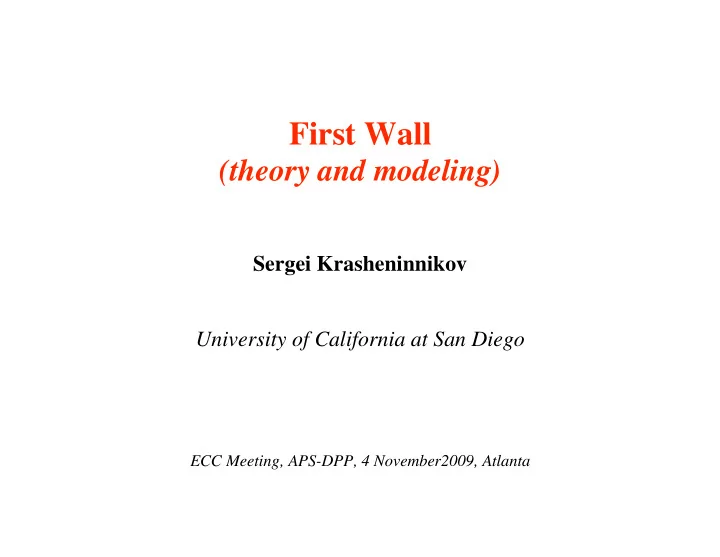

First Wall (theory and modeling) Sergei Krasheninnikov University of California at San Diego ECC Meeting, APS-DPP, 4 November2009, Atlanta
• High quality discharges require some special training of first wall (e.g. glow discharge cleaning, boronization, etc.) • However, crucial importance of wall physics already follows from the fact that amount of hydrogen stored in saturated wall is ~10 2-3 � of hydrogen in tokamak volume • Release of even small portion of hydrogen stored in the wall can be fatal for tokamak performance • Nevertheless, we still do not understand wall processes and are not able to make quantitative (and even qualitative) prediction of both wall and coupled wall-plasma performance • Wall physics is VERY complex: • It includes physical (e.g. physical erosion, phase transition) and chemical (e.g. chemical erosion, formation/braking of chemical bonds) processes having strong synergetic effects (e.g. in multi-mat. walls) • It is characterized by a large variation of spatial (10 orders) and temporal (13 orders) scales • Synergy of plasma transport and wall processes is envisioned
Schematic view of some of wall processes (courtesy of Brian Wirth and Dennis Whyte)
• In our models we usually consider wall having nice smooth surface, but experiment shows very different pictures: Pyrolytic graphite before and after exposure by D-plasma for 5000 s (Doerner, 2009)
Surface in LHD (Sagara et al., J. Nucl. Mater, 2003)
Thick (up to 1 mm) co-deposits found on the rear side of the toroidal belt pump limiter at TEXTOR (Rubel, 2001)
2000 s, 1120 K 9000 s, 1120 K 60 eV He + 60 eV He + PISCES-B PISCES-B 22 000 s, 1120 K pure He plasma 60 eV He + R pure He plasma N PISCES-B ~4 ITER shots 0 pure He plasma ~20 ITER shots 6 ~2g m -2 (fuzz) ~3g m -2 (fuzz) 1 8 ~50 ITER shots 2 ~6g m -2 (fuzz) 0 0 7 “Fuzz” on tungsten surface exposed by He plasma (Ohno, 2006; Baldwin, 2008)
Carbon deposits in Tore Supra (Roubin, 2009) • Should we care much about “fuzz”/co-deposits/films? • Yes! They can bury a lot of tritium and crucially affect plasma performance:
In Tore Supra co- deposited films, saturated with hydrogen, critically limited operational window by promoting “hot spots” formation leading to hydrogen/impurity ejection and discharge termination (Tsitrone et al., IAEA-2008, similar effects are also reported by Fenstermacher et al., 1997; Holmann et al., 2003; Takenaga et al., 2005; Fujita et al., 2006)
• Often long pulse/high power discharges in current devices are terminated by accidental massive invasion of dust (e.g. “sparks” in LHD), released from the wall, probably, due to thermal stresses in hot spots These experiments clearly demonstrate the synergy of plasma-wall interactions!
• The main questions for the first wall physics studies are: i) How much we should know about wall processes in order to succeed with fusion reactor? (I have no good answer!) and ii) How we can describe/model them? Now we have: • The Molecular Dynamics (e.g. Krstic, et al., New J. Physics, 2007) and Molecular Kinetic (e.g. TRIDYN) codes - give the most accurate and comprehensive description (providing that the interaction potentials are available), but way too slow and cannot be used for transport time scales • Continuous transport models (e.g. Bonnin et al., EPS-2007, Pigarov, et al., J. Nucl. Materials, 2009 ) describe 1D time evolution of averaged wall/hydrogen densities based on the implementation of key observations from MD simulations and experimental data (including implantation, trapping, desorption, erosion, etc.)
• Continuous models capable of modeling on transport time scales and give reasonable agreement with some experimental data E. g. the results of WALLPSI (Pigarov, 2009) on trapped D retention in C and Be agree well with experimental data from (Roth JP 2008) • However: - these models cannot deal with such “critical” effects as phase transitions, chemistry effects (e.g. in mix-material case) and cannot describe peeling off the films, dust generation, etc.
Conclusions • How to improve our simulation of first wall physics? • Combination of MD, MC, and continuous codes comes to mind, but how to do it in an intelligent way? • However, it will be not enough: how to describe phase transitions, peeling off the films, “fuzz”, dust formation, etc… • Obviously that more well thought of and well diagnosed dedicated experiments will help (e.g. see ReNeW report) • Consolidation of theorists and modelers working on first wall issues should also help • Additional funding will not hurt either … • Still: How much we actually need to know about wall processes in order to succeed with fusion reactor? P.S. Production of cars is going on for more than 100 years, but scientists still cannot model the combustion engine from first principals…
Conclusion (continued) We still have a lot of things to do in our lives!!!
Recommend
More recommend